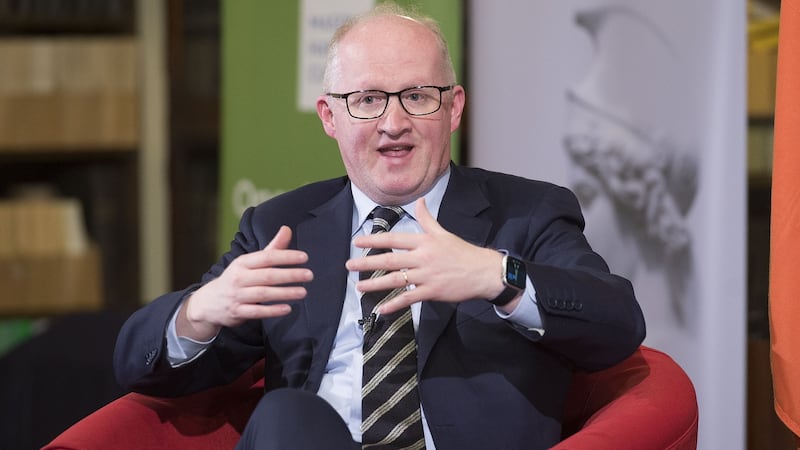Market bets on the scale of interest rate increases in coming months are changing fast — backed up by warnings from central bankers of the need to clamp down on runaway inflation. A 0.75 of a percentage point rise in ECB rates next Thursday is now a possibility and a hike of at least 0.5 of a point is a certainty.
Tracker mortgage rates will rise further and banks will also start to pass on the higher rates to other variable rate borrowers, and to adjust upwards their fixed rate offers for new borrowers.
Apart from tracker rates, the bigger lenders have largely held off after the first ECB hike before the summer, but another increase and the near-certainty of more to come will mean they will move this time.
1. What has changed?
Central bankers are scrambling to catch up with inflation, which now looks like being both higher and more persistent than they had reckoned on.
READ MORE
Interest rates in the euro zone rose in July for the first time in over a decade but the key ECB rate is still only 0.5 per cent, while the latest data showed inflation across the single currency area of 9.1 per cent.
As well as soaring energy prices, many food items are now increasing by 10 per cent or more and the core rate of inflation — which excludes the volatile food and energy elements — has risen to 4.3 per cent.
So lights are flashing red in Frankfurt, where the inflation target is 2 per cent. The rate of price increases will decline at some stage from current stratospheric levels, but the ECB council is worried that a rate well above its 2 per cent target will get embedded in the economy.

2. How have markets reacted?
There has been a significant change in market expectations of where interest rates are heading. One measure of this is the interest rates on longer-term government borrowings, which have risen sharply across Europe.
The interest rate on Ireland’s ten year debt has risen to 2.25 per cent, from an August low of below 1.5 per cent. (It briefly spiked to 2.5 per cent earlier in the summer) Market expectations of future ECB interest rates have also changed markedly.
A further rise of some two percentage points in ECB interest rates is now priced in to take place by next summer — these market “ bets” can swing around quickly, but for now investors are listening to the message from ECB policymakers that they are going to move in a determined way to clamp down on inflation.
3. What are the arguments?
The ECB governing council is split between so-called hawks and doves — those who want to move quickly to hike interest rates and those who want to move more slowly.
The debate continues, as shown over the last week by speeches from ECB council members Isabel Schnabel and Philip Lane, the Irishman who has been a leading force for not hiking rates too quickly.
Schanabel, speaking at the forum for central bankers in Jackson’s Hole in Wyoming at the weekend said the risk of high inflation rates becoming entrenched in people’s expectations was now “ uncomfortably high” and that central banks needed to respond “ forcefully.” The longer inflation remains high, the more the public will lose confidence in the ability of central banks to hold it down, she warned.
She set the decision facing central banks, including the ECB, in the context of the huge uncertainties which have hit the world economy with Covid followed by the war in Ukraine possibly ushering in a new era of volatility.
The role of monetary policy against this backdrop is controversial, she said, particularly as the root of inflation this time is a supply side shock as energy and food prices soar and supply chains remain in trouble.
But despite the costs that higher interest rates will impose on economies already under pressure, Schnabel argues that the correct path for central banks is to respond strongly to higher inflation “even at the risk of lower growth and higher unemployment.” The potential longer-term economic price of not acting quickly, she argues, could be even greater.
She argues that current uncertainty about how the persistence of inflation means central banks must act quickly, and that this is essential for their credibility. And that the way economies work today means that if inflation did get entrenched, the cost of the required central bank action to shake it out of the system would be really large.
Philip Lane, speaking in Barcelona, put a different view. He argues for a “step-by step” approach to increasing interest rates, implying smaller initial increases but still the possibility of a steady upward move in interest rates.
A steady pace of increase towards what he calls the “ terminal rate” — the eventual target rate — would allow the ECB to monitor the impact on financial conditions across the euro zone.

Energy crisis: Are businesses ready to deal with blackouts?
[ Irish borrowers could be facing a season of rapid ECB interest rate hikesOpens in new window ]
Importantly, he says, given the uncertainty about where inflation is going and how higher interest rates will affect this, a slower pace of increases gives the ECB more space to adjust its course in the light of evidence “ if circumstances change.” The ability to adjust the scale and speed of rate hikes against an uncertain backdrop “ remains vitally important,” he argues.
Lane also puts a different slant on the key issue of the expectations of financial markets on future inflation. By and large, he argues, while there is concern about the short-term inflation surge, they still expect inflation to moderate to near ECB target levels in the longer term. He also underlines the expectations of a slowdown in economic growth, which could in itself act to lower inflation by cutting consumer and business demand.
The kind of inflation shock we are witnessing, driven by higher energy and food prices rather than by a surge in spending and borrowing, are less likely to feed through to longer-term inflationary problems, he argues.
The argument shows that for all the analysis and research undertaken, in a time of inflationary crisis, central banking is at much an art as a science. Schnabel and Lane are looking at the same picture, but seeing different things.

4. Who will win the argument?
Right now, it is clear that the “hawks” are winning the argument. A string of central bank heads from Germany, the Netherlands and the Baltic countries have been out in recent days calling for firm action.
The mood from the Jackson’s Hole meeting clearly pointed to higher rates internationally. That said, what will happen in the months ahead remains hugely uncertain. Wholesale gas prices have swung around massively over the past week alone, though they are still dangerously elevated.
Higher energy prices for households and the feed through of higher energy prices on business costs are likely to keep inflation readings high heading into the Autumn, with some predictions that the euro zone — and Irish rates — could for a time move into double digits. But how the ECB would react if the euro zone economy hit a recession, for example, remains uncertain.
Does it dig in and keep increasing interest rates no matter what the cost, or reckon that recession itself will slow demand and bring inflation down?
For now, the odds are rising on a 0.75 point rise next Thursday, though market opinion remains divided. But whether this happens or not, the signals are that the pace of ECB rate rises is going to be quicker than had been anticipated a few months ago, with significant implications for Irish borrowers,.
Tracker holders have been first hit — the 0.5 point hike in July will have cost someone with a €200,000 loan around €50 extra month. They will face the same again after next week’s hike, or perhaps a hike of around €75 a month if the ECB goes for a 0.75 point hike.
And while some smaller lenders have already hiked other rates, the increase next week will almost certainly bring Bank of Ireland, AIB and Permanent TSB on to the pitch to increase variable rates as well as the automatic tracker hike,. Meanwhile offers for new borrowers will be significantly repriced in the weeks ahead. The era of super-cheap borrowing is drawing to a close.


















